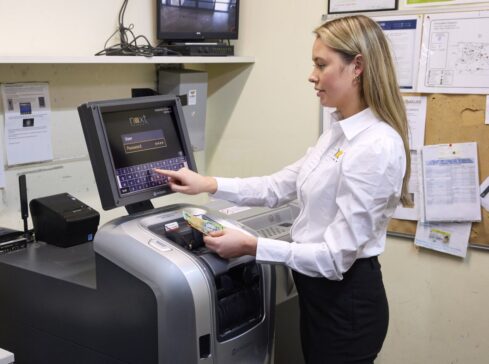Shifting Branch and Cash Landscape Europe
The French banking landscape has shifted dramatically in recent years. According to recent surveys, the closure of bank branches is accelerating throughout France and much of the world. When asked, the primary reason cited by financial institutions is the drop in footfalls and the rise of digital banking.
In spite of this, France remains a European exception: playing home to almost one-fifth of all branches in Western Europe. The same phenomenon is observed in the countries bordering France, as Belgium has also fallen from more than 17,000 branches in 1993 to less than 3,000 at the end of 2024, and Luxembourg has also lost 20% of its bank branches since 2015.
Aside from access to banking consultation and advice, access to cash is also shrinking due to this disappearance of banking facilities. Indeed, in France, the number of ATMs has steadily decreased in France, from nearly 60,000 ATMs 10 years ago to less than 50,000 today. This same trend has also been observed in Belgium and Luxembourg over the same period where recent reports show there are currently about 73 ATMs per 100,000 inhabitants in France, 58 per 100,000 in Luxembourg and only 37 per 100,000 inhabitants in Belgium.
Yet in these 3 countries, even though the number of cash withdrawals per year and per capita has steadily decreased, the total amounts withdrawn have only continued to increase. In 2025, in France and the “Belux” region, cash still represents between 37% and 50% of payments and forecasts, with some predictions indicating that cash will continue to account for around a third of all transactions in this region by the end of the decade.
Growing Interest in the Cash Economy
The difficulties of maintaining access to cash are of great concern to citizens and public authorities who are asking financial institutions to maintain a sufficient network in the territories. This new situation has paved the way for a redefinition of cash distribution.
Initially, independent operators (IADs) seized the opportunity to deploy their own ATM networks. In France and Belgium, the main players are the cash-in-transit companies that can control the entire value chain necessary to operate an independent network of ATMs. International companies specialising in this activity are also present as they see a market for opportunity. This makes it possible to ensure the distribution of and access to cash in high-traffic areas (ex. train stations, airports, shopping centres in particular) or in rural areas neglected by banks – particularly as a result of agreements between these companies and municipalities.
With these additional players coming into the market most French, Belgian or Luxembourg financial institutions (at the same time as in other European countries such as the Netherlands or Sweden) have been rationalising their ATM networks in the past 5 years.
Shared Solution to Maintaining Cash Access
Given the need to service their customers and maintain access to cash and their banking services, Banks in the region have two solutions available:
- To group together in a joint subsidiary to pool their network of ATMs. This operation is referred to as “ATM Pooling”.
- To outsource your ATM fleet to an independent operator. This solution has been chosen by Groupe BPCE in France, which has entrusted the entire management of these machines to the long-distance transport company Brinks since 2021.
ATM pooling consists of collecting the resources from several banks or financial players to manage a common, unified ATM fleet, rather than each bank having its own independent network. This applies to both physical infrastructure (machines, premises), their maintenance, their cash supply, logistical costs (cash transport, security), and sometimes the associated services (deposits, cheque deposits, banknote recycling, etc.). The main objectives of ATM pooling are:
- Cost reduction (maintenance, operation, safety, logistics)
- Rationalization of the fleet to avoid redundancies (several PLCs in the same area)
- Maintaining or improving accessibility (rural areas, sparsely populated municipalities), despite the closure of physical bank branches or the decrease in the use of cash
- Improvement of the services provided to users (multifunctional, accessibility, safety)
- Beneficial environmental effects such as reduced cash transport, more efficient machines, reduced energy footprint.
How ATM Pooling is Transforming Bank Operations
In France, Belgium, and Luxembourg, we are currently seeing ATM pooling projects or structures being set up to meet these challenges.
In France, the main multi-migration project is the “Cash Services” project via the 2SF joint venture. Three major French banks (BNP Paribas, Société Générale, Crédit Mutuel / CIC) have joined forces via the company 2SF (Société des Services Fiduciaires) to pool around 15,000 ATMs under the “Cash Service” brand with the intend to gradually scale down this ATM network to around 10,000 ATMs by 2025–2026, spread across 7,000 sites (5,000 in branches, 2,000 excluding branches). Priority has been given to pooling in urban areas where there is a lot of overlap between brands, but also coverage in rural or peri-urban areas where financial services have gradually disappeared. Through this ATM pooling initiative all the usual services of self-service banking are offered, namely cash withdrawals, cheque and cash deposits, and checking accounts.
Across the border in Belgium, the Batopin project (“CASH points”) brings together the main Belgian banks (ING, BNP Paribas Fortis, Belfius, KBC). In 2023, 170 new pick-up points opened; with about 533 new machines installed. By the end of 2025, 2,500 ATMs spread over 950 “CASH points” locations are expected to be deployed. The objective is for 95% of Belgians to have a CASH point within a radius of 5 km. This poses several challenges for Batopin such as finding suitable locations (security, accessibility, parking), obtaining authorisations, and meeting installation deadlines (6-7 months). Recently, an agreement was reached with the government to maintain access to a certain number of ATMs (4,000) until 2027.
Lastly, in Luxembourg, the Bancomat project (a commercial brand of the company Luxconstellation) originated in six major Luxembourg banks (Spuerkeess, BIL, BGL BNP Paribas, Banque Raiffeisen, POST Luxembourg, ING Luxembourg). One of the objectives is to modernize cash handling equipment by deploying more than 80% of equipment that automatically recycles banknotes deposited by merchants or individuals to redistribute to customers. In doing so, Luxconstellation will be able to achieve a homogeneous network of ATMs.
We summarise the main challenges of pooling or outsourcing ATM networks as follows:
- Decline in the use of cash: cash withdrawals and cash payments are gradually decreasing in many of these countries, which weakens the profitability of ATMs.
- Closure of bank branches: reduction in physical locations, encouraging compensation with more distributed self-service points.
- Regulation and public agreements: often the need for interactions with public authorities to guarantee access to cash, territorial equity, and obligations in sparsely populated or underserved areas.
- Technological modernization: new vending machines that are safer, more accessible, more efficient (energy, recycling), and equipped with more services.
- Logistics optimisation and economies of scale: fewer machines, but better placed and used, better distribution, shared upkeep and maintenance, optimised cash transport.
The main benefits of these ATM pooling initiatives are:
- For users: potentially fewer vending machines in some highly congested areas, but better overall service, with fewer distances to travel in underserved areas.
- For banks: cost reduction, better efficiency, but requires additional coordination and the sharing of revenues/fees, management.
- For the environment: reduction in cash transport, more economical machines, less duplication of equipment.
As the world leader in ATM solutions, Hyosung is able to support the players in this new ATM environment by offering next-generation solutions designed for multiple banks, co-branding, and with interfaces that are compatible with modern features: banknote recycling, accessibility options (lowered keypad, audio, etc.), enhanced security, and better energy efficiency. We also offer maintenance and service solutions to meet the needs of a shared fleet. In addition, our centralized management platforms manage the status of the fleet (remote monitoring, alerts, etc.), which is ideal for ATM networks managed and operated by several banks at once.
Whether you’re looking to outsource your fleet or looking to engage in ATM pooling, contact your local Hyosung representative to see how our solutions can help optimize your self-service banking channel.




